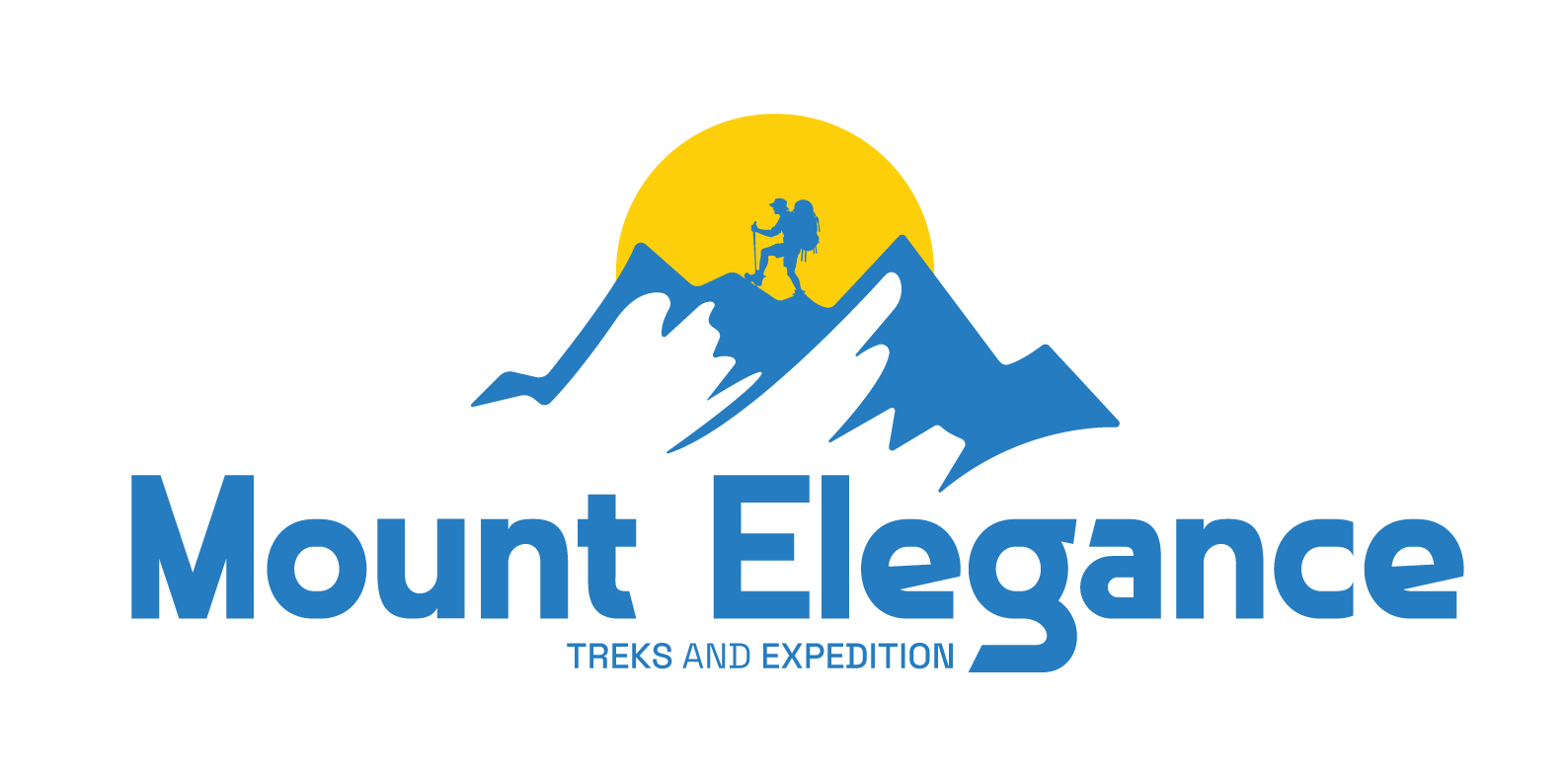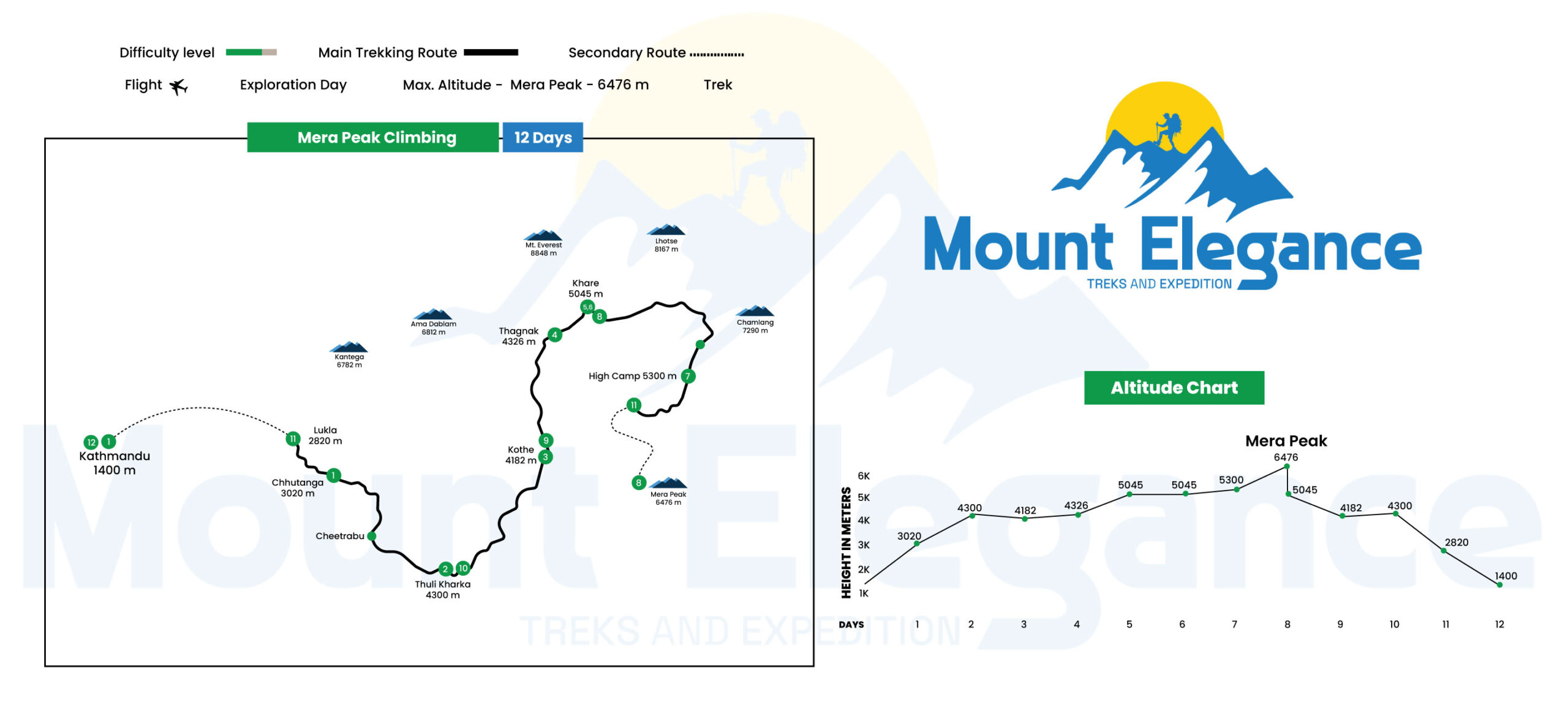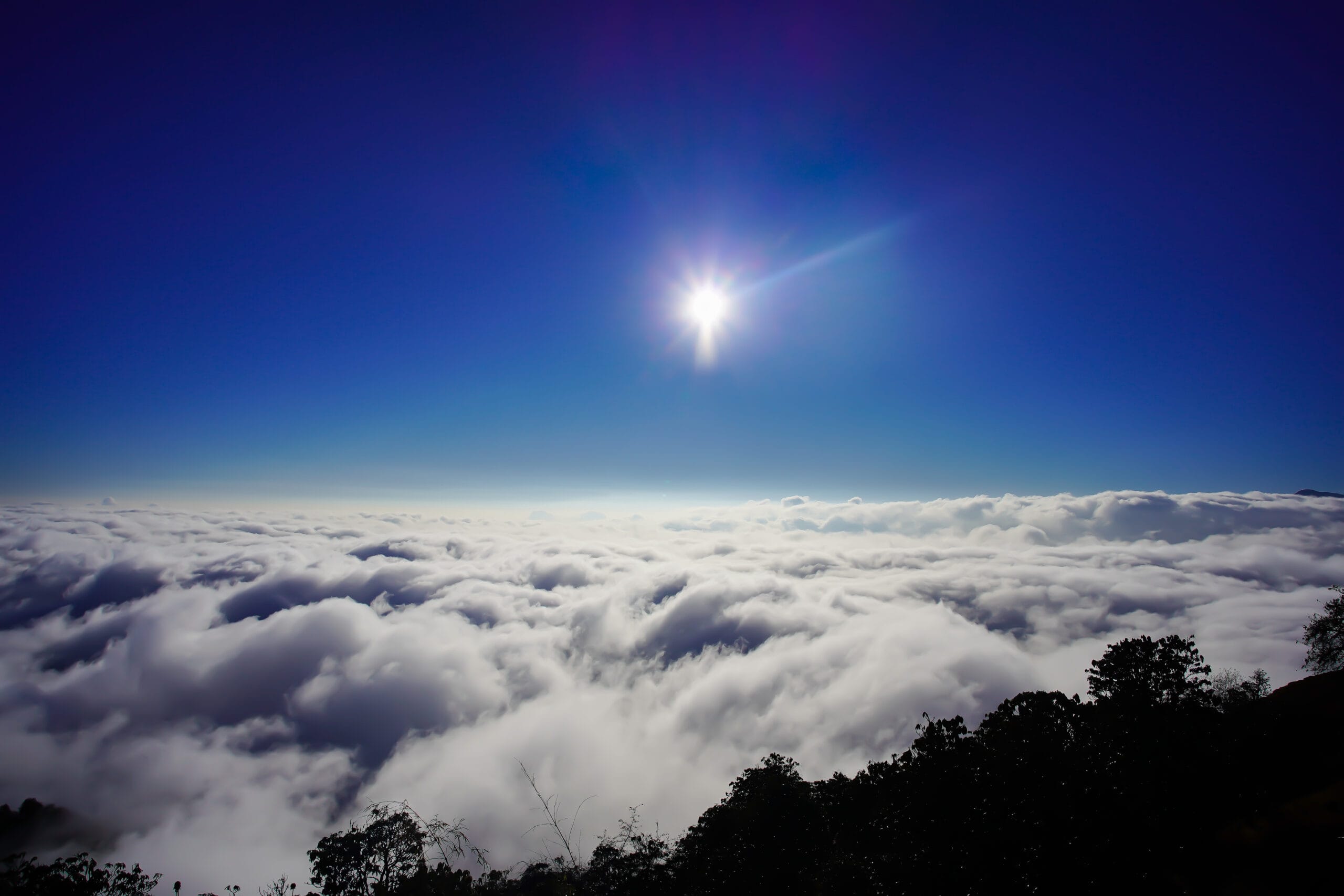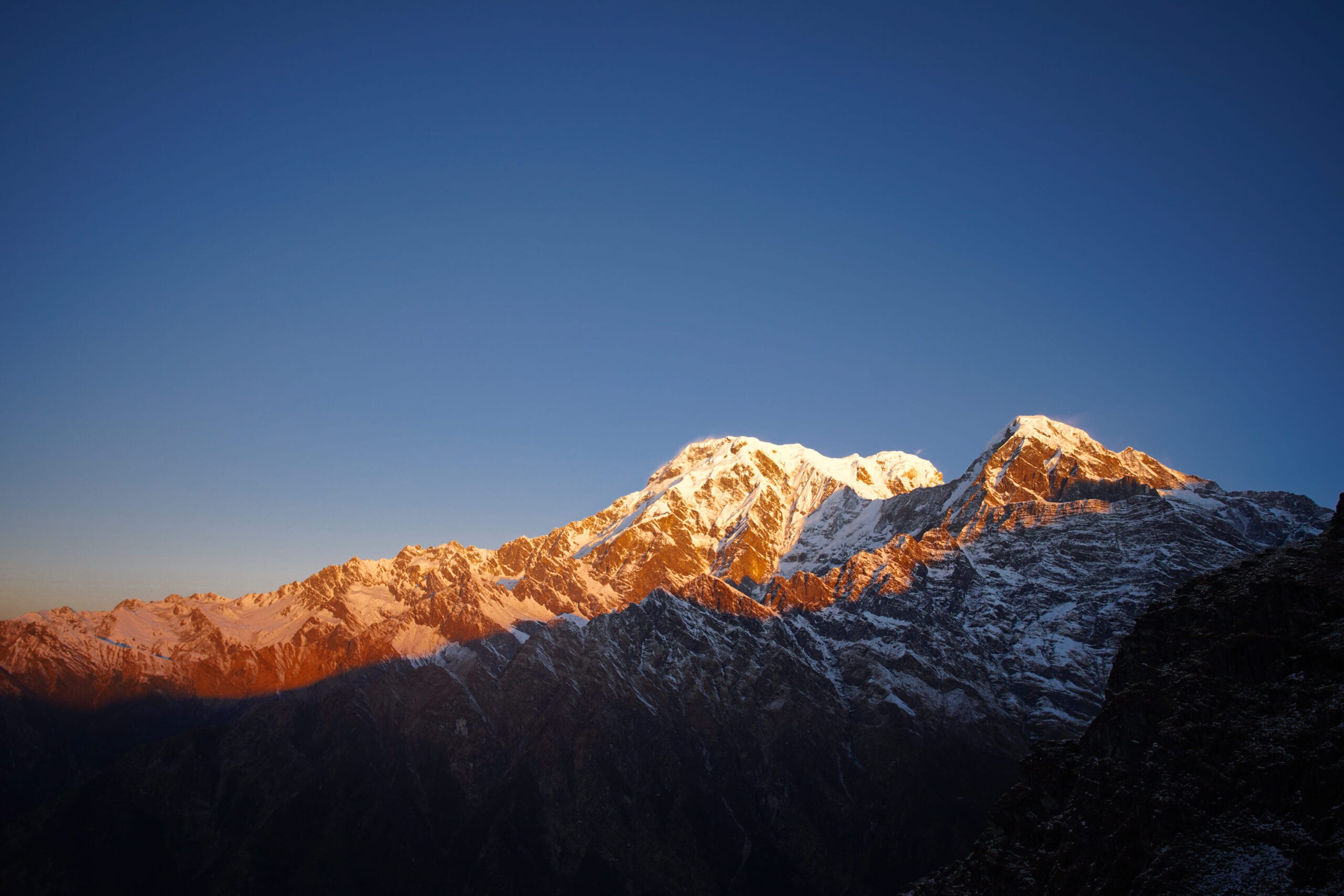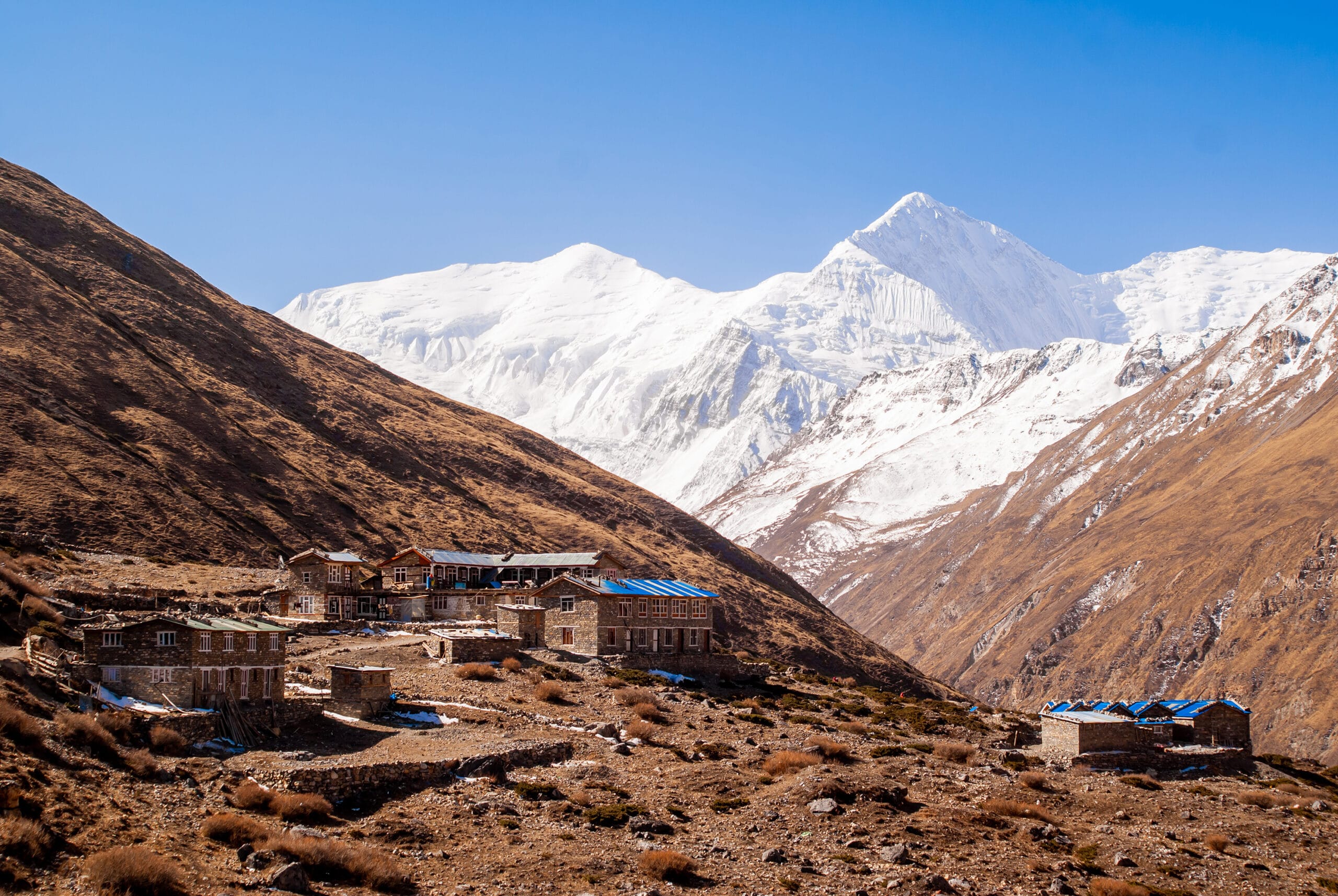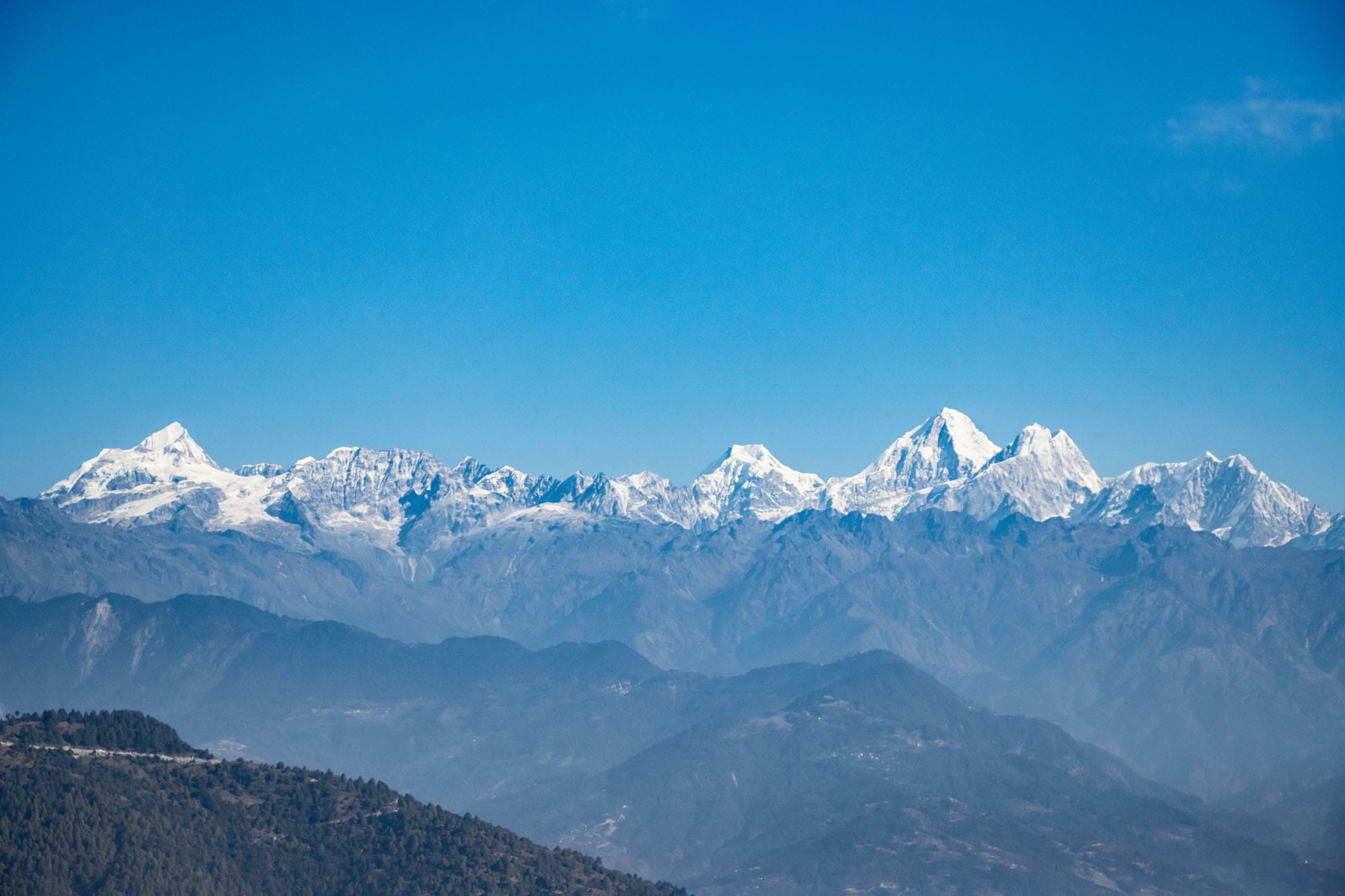Mera Peak Climbing – 12 D
Best Season
Highest Altitude
Trip Overview
Embark on a thrilling journey to Mera Peak Climbing – 12 days the highest trekking peak in Nepal, nestled in the remote wilderness of the Hinku Valley within the Everest region. This 12-day expedition offers the perfect blend of adventure, solitude, cultural immersion, and panoramic Himalayan vistas. Designed for those with a good level of physical fitness and a thirst for high-altitude challenges, Mera Peak provides a non-technical yet demanding climb, making it ideal for beginner climbers and experienced trekkers alike.
Your adventure begins with a scenic flight to Lukla, followed by a less-trodden trail through rhododendron forests, traditional Sherpa villages, and pristine alpine landscapes. As you trek through Panggom, Ramailo Danda, and Khare, you will gradually acclimatize while being rewarded with breathtaking views of Everest, Lhotse, Makalu, Cho Oyu, and Kanchenjunga. With expert guides, proper acclimatization days, and professional climbing support, the final ascent to Mera Peak promises an exhilarating and rewarding summit experience.
Trip highlights of Mera Peaking Climbing – 12 days
- Conquer Nepal’s highest trekking peak, Mera Peak (6,476 m), with panoramic views of five 8,000+ meter giants.
- Begin your adventure with a thrilling mountain flight from Kathmandu to Lukla.
- Trek through pristine alpine forests, remote valleys, and culturally rich Sherpa villages.
- Experience breathtaking views of Everest, Lhotse, Makalu, Cho Oyu, and Kanchenjunga from the summit.
- Acclimatize gradually with a carefully planned route through the Hinku Valley.
- Enjoy expert-guided climbing with full support, safety measures, and technical gear.
- Immerse yourself in the raw wilderness and solitude of the less-trodden Mera Peak route.
Porter service (up to ~15 kg), WiFi and charging available in most lodges.
This trek offers not just a physical challenge but also a journey through one of the world’s most spectacular landscapes.
Essential Items:
- Base Layers: Thermal top and bottom
- Insulation: Fleece jacket and down jacket
- Outer Layer: Waterproof jacket and pants
- Trekking Clothes: Some pairs of trekking pants, quick-dry shirts
- Footwear: Trekking boots, camp shoes/sandals
- Headwear: Sun hat, warm hat, neck gaiter
- Hand-wear: Lightweight gloves, insulated gloves
- Accessories: Sunglasses, sunscreen, lip balm , headlamp with extra batteries , trekking poles ,50-60L backpack + daypack
- Personal Items: Hygiene essentials (toothbrush, toothpaste, wet wipes), Quick-dry towel ,Water bottle or hydration system (2L capacity), Snacks (energy bars, nuts)
- Medical Kit: Personal medications, basic first aid, altitude sickness pills
- Documents: Passport, trekking permits, travel insurance
- Optional: Camera, power bank, Lightweight sleeping bag
Refer to this for the full Equipment Checklist
Itinerary
Flight Duration: 35 minutes
Trek Duration: 4–5 hours
Highest Altitude: 2,730 m / 8,957 ft
Meals: B/L/D
After a scenic mountain flight to Lukla, the trek begins with a gentle descent through rhododendron forests and farmlands. You’ll pass small Sherpa settlements and cross ridges before reaching Paiya, a peaceful village surrounded by terraced fields. It’s a perfect place to rest and soak in the mountain atmosphere.
This day is crucial for easing into the trek’s pace while giving your body time to start adjusting to the increasing altitude.
Trek Duration: 6–7 hours
Highest Altitude: 2,846 m / 9,337 ft
Meals: B/L/D
Your day begins with a hearty breakfast in Chutunga, preparing you for one of the most challenging yet rewarding sections of the Mera Peak climbing journey. The trail quickly ascends through rhododendron and pine forests before transitioning to rugged alpine terrain. As you approach the Zwatra La Pass at 4,610m, the air becomes thinner, and the views begin to expand dramatically.
After savoring the views, the trail descends gradually through yak pastures and open ridges, eventually reaching Thuli Kharka, a beautiful pastureland surrounded by rolling hills.
Trek Duration: 6 - 7 hours
Highest Altitude: 4,300m
Meals: B/L/D
Leaving Thuli Kharka, the trail offers a scenic descent through a mix of alpine meadows and dense rhododendron forests. As you trek, you’ll be treated to magnificent views of Mera Peak, Kusum Kanguru, and Peak 43, which seem to follow you along the ridge. The path undulates over several ridges, gradually leading to the Hinku Valley. The air becomes crisp, and the landscape transforms into lush greenery, with moss-covered rocks and streams running alongside the trail.
Kothe is a peaceful stopover known for its traditional lodges and warm Sherpa hospitality. From here, the towering Mera Peak becomes more prominent, igniting the excitement for the climb ahead. The sound of the rushing river and the scent of pine create a tranquil environment, perfect for relaxation after a long day’s trek.
Trek Duration: 6–7 hours
Highest Altitude: 3,600 m / 11,811 ft
Meals: B/L/D
After a nourishing breakfast in Kothe, the trek begins by following the upper Hinku Valley alongside the serene Hinku River. The trail gradually ascends through dense forests of rhododendron, pine, and moss-covered birch trees before opening into alpine pastures. You will notice a stark change in the scenery as the lush greenery slowly gives way to rugged, glacial landscapes. Along the way, the views of Mera Peak’s south face become more striking, with its icy summit gleaming in the distance.
The highlights of this day include the first clear, close-up views of Mera Peak and the opportunity to witness the dramatic shift from forested trails to high alpine terrain. The journey offers a perfect mix of peaceful nature and inspiring mountain panoramas, making it one of the most memorable sections of the trek.
Trek Duration: 4–5 hours
Highest Altitude: 5,045 meters
Meals: B/L/D
The trek from Thangnak to Khare is a crucial acclimatization stage in your Mera Peak Climbing adventure. The trail gradually ascends through the stunning Dig Glacier and alongside the Dig Kharka meadow, offering jaw-dropping views of Charpate Himal. As you continue, you will cross moraines formed by the Hinku Nup and Shar Glaciers, a surreal experience that blends adventure with awe-inspiring alpine scenery.
Reaching Khare, also known as Mera Peak Base Camp, you will be surrounded by a magnificent amphitheater of Himalayan giants, including the impressive north face of Mera Peak. This small settlement serves as the final preparation hub before ascending higher.
Highest Altitude: 5,045 meters
Meals: B/L/D
This day is dedicated to acclimatization at Khare, a vital step to ensure your body adjusts properly to the thin air before pushing higher toward Mera Peak. Instead of a long trek, you will embark on short hikes around the Khare area, often climbing to higher ridges for the "climb high, sleep low" approach.
These hikes reward you with jaw-dropping views of Mera Peak’s northern slopes, surrounding glaciers, and peaks like Kyashar and Peak 41. The crisp mountain air, shimmering ice formations, and the quiet majesty of the high Himalayas make it an unforgettable day.
Trek Duration: 5–6 hours
Highest Altitude:5,780 m
Meals: B/L/D
The journey from Khare to Mera Peak High Camp is one of the most thrilling and physically demanding sections of the climb. After breakfast, you begin the ascent on a steep trail that leads toward the Mera Glacier, putting your ice axe, crampons, and mountaineering skills into practice. The route involves crossing crevassed areas and moving steadily up snow slopes, all while soaking in the stunning views of the Hinku Valley behind you.
From High Camp, the panorama is simply breathtaking — Everest (8,848 m), Lhotse (8,516 m), Makalu (8,481 m), Cho Oyu (8,188 m), and Kanchenjunga on a clear day dominate the horizon. As you rest and hydrate, you prepare mentally and physically for the summit push in the early hours of the next morning
Trek Duration: 8–10 hours
Meals: Breakfast, Lunch, Dinner
Highest Altitude: 6,461 m (Mera Peak Summit)
Today is the most awaited and challenging day of the Mera Peak Climbing adventure. The climb begins early in the morning, usually around 2–3 a.m., to ensure reaching the summit before strong afternoon winds.
The ascent involves a gradual climb with some technical sections, requiring steady pacing and good teamwork. As dawn breaks, the snowy slopes glow golden under the rising sun, creating an unforgettable scene.
Trek Duration: 4–5 hours
Meals: Breakfast, Lunch, Dinner
Highest Altitude: 5,045 m (Khare) – descending to 3,600 m (Kothe)
After successfully summiting Mera Peak and enjoying a well-earned rest at Khare, the journey takes you downhill towards Kothe. The day begins with a hearty breakfast before retracing the trail through Thangnak and along the Hinku River valley. The descent is refreshing, with the crisp mountain air and the sight of green vegetation gradually returning.
As you arrive in Kothe, you’ll be welcomed by the warmer climate and the comforting ambiance of the village’s teahouses. Here, you can unwind, share summit stories with fellow trekkers, and savor hearty Sherpa meals. The return to Kothe marks a symbolic shift from the challenge of the high mountains to the peaceful charm of the lower trails.
Trek Duration: 6–7 hours
Meals: Breakfast, Lunch, Dinner
Highest Altitude: 3,900 m (Thuli Kharka)
Today you’ll trek from Kothe back toward Thuli Kharka, retracing part of your earlier route but now with a deeper appreciation of the stunning landscape. The trail gradually ascends through lush rhododendron and pine forests, offering peaceful moments alongside bubbling streams and shaded paths.
Along the way, panoramic views of towering peaks such as Mera and Kusum Kanguru accompany your journey, making each step inspiring. The natural beauty and tranquility of the alpine meadows at Thuli Kharka provide a perfect spot to rest and rejuvenate after several days of demanding trekking and climbing.
Trek Duration: 7–8 hours
Meals: Breakfast, Lunch, Dinner
Highest Altitude: 2,860 m (Lukla)
Today marks the final day of your trek as you descend from the serene highlands of Thuli Kharka back to the bustling mountain town of Lukla. The trail winds through lush forests, charming villages, and terraced fields, offering a gentle but long descent. Along the way, you can enjoy the vibrant local culture and stunning views of the surrounding hills and valleys.
Arriving in Lukla, the gateway to the Everest region, you’ll find a lively atmosphere filled with trekkers and locals. It’s the perfect place to celebrate the successful completion of your Nar Phu Valley adventure, relax in cozy teahouses, and savor delicious meals. The day’s long walk provides ample opportunity to reflect on the remarkable journey you’ve experienced amidst some of the most breathtaking mountains.
Flight Duration: Approximately 30–40 minutes
Meals: Breakfast (typically at Lukla) & Farewell dinner in Kathmandu
Highest Altitude: 1,400 m (Kathmandu)
After breakfast, you’ll take a short but spectacular mountain flight from Lukla back to Kathmandu. The flight offers breathtaking aerial views of the Himalayas, including famous peaks like Everest, Lhotse, and Nuptse, weather permitting. Arriving in Kathmandu, you’ll be greeted by the bustling city atmosphere, a striking contrast to the peaceful mountain landscapes you’ve just explored.
This marks the end of your Nar Phu Valley Trek adventure. Depending on your schedule, you can relax at your hotel, explore Kathmandu’s vibrant culture and historic sites, or prepare for your onward journey. The day is perfect for rest and reflection after an incredible trekking experience through one of Nepal’s most remote and beautiful regions. A farewell dinner with traditional Nepali cuisine is a great way to celebrate the successful completion of your trek which is hosted by mount elegance team.
Book Now
Send an Inquiry
Got A Question?

Mr. Shishir Dhakal
Price Inclusion
- Airport transfers and domestic flights between Kathmandu and Lukla are included.
- All necessary trekking permits and Mera Peak climbing permits are covered.
- Full board meals (breakfast, lunch, dinner) during the trek and climb are provided.
- Accommodation in teahouses and tented camps during the trek and climb is arranged.
- Experienced, government-licensed trekking and climbing guide with supporting staff are included.
- Group climbing gear such as ropes, ice screws, and snow bars are provided by the agency.
- Medical kit, emergency oxygen, and satellite phone for communication are included for safety.
- Seasonal fresh fruit as dessert every evening after dinner.
- Mount Elegance free Tshirt and Route map.
- Oximeter to measure the Oxygen (For awareness of the high altitude sickness).
- Duffel bag and sleeping bag for trekking (Should be returned after trek completion).
- One porter for two trekkers.
- Farewell dinner at the end of the trek.
- Certificate after trek completion.
Price Exclusion
- International airfare to and from Kathmandu.
- Nepal entry visa fees.
- Personal trekking equipment and gear.
- Tips for guides and porters.
- Extra expenses such as bar bills, laundry, and telephone charges.
- Travel insurance for personal loss, injury, or illness.
Additional Information
Trip Map
Meals and Accommodation
The Trek offers an iconic trekking experience filled with breathtaking landscapes and cultural immersion. Accommodation and meal arrangements along the route are designed to provide comfort and sustenance throughout this journey.
Accommodations in Kathmandu and on the Trek
In Kathmandu, you’ll stay in a standard hotel equipped with modern amenities and complimentary WiFi to help you unwind and prepare for the trek.
Along the trail, you’ll stay in teahouses that provide cozy rooms with basic amenities, typically in shared or twin-sharing setups. Most teahouses feature communal dining areas where you can enjoy meals and connect with other trekkers. Facilities like hot showers, charging outlets, and WiFi are available at many lodges along the route, but extra charges may apply.
Meals on the Trek
Full-board meals, including breakfast, lunch, and dinner, are provided during the trek. The meals typically consist of a variety of healty options with Nepali, Tibetan, and international influences, such as dal bhat, noodles, and soups. Breakfast is included in Kathmandu, while you’ll have access to a range of local and international dining options in the city for other meals.
Best Season for Mera Peak Climbing
Spring (March to May)
- Weather: Mild temperatures, blooming rhododendrons, and clear skies.
- Temperature:
- Lower elevations (2,860m to 3,500m): 10°C to 20°C during the day, 0°C to 5°C at night.
- Higher elevations (up to 5,644m): -5°C to 10°C during the day, -15°C to -5°C at night.
- Highlights: Vibrant landscapes and moderate temperatures make this an excellent time to trek to Everest Base Camp and climb Kala Patthar.
Autumn (September to November)
- Weather: Stable, clear skies and comfortable temperatures.
- Temperature:
- Lower elevations (2,860m to 3,500m): 10°C to 20°C during the day, 0°C to 5°C at night.
- Higher elevations (up to 5,644m): -5°C to 10°C during the day, -15°C to -5°C at night.
- Highlights: Post-monsoon clarity offers spectacular views, making it a popular season for panoramic vistas of Everest.
Winter (December to February)
- Weather: Cold, with potential snow in higher areas.
- Temperature:
- Lower elevations (2,860m to 3,500m): 0°C to 10°C during the day, -5°C to 0°C at night.
- Higher elevations (up to 5,644m): -10°C to -5°C during the day, -20°C to -10°C at night.
- Challenges: Fewer trekkers, quieter trails, but colder conditions, with snow potentially making some areas more difficult to access.
Equipment Checklist
Trekking in Nepal is an incredible adventure, taking you through diverse landscapes, from lush forests to rugged mountain trails. To fully enjoy the experience, it’s crucial to pack the right equipment. Here’s an essential checklist to help you prepare for your trek, ensuring you’re ready for the challenges and beauty of the Himalayas.
1. Clothing
- Base Layers: Moisture-wicking base layers (thermal tops and bottoms) are essential for regulating your body temperature. Opt for lightweight, breathable materials.
- Mid Layers: Fleece jackets or lightweight down jackets provide warmth in colder temperatures. These layers should be easy to add or remove as needed.
- Outer Layers: A waterproof and windproof jacket is essential to protect against rain, wind, and snow. Make sure it’s breathable to stay comfortable during strenuous activities.
- Trekking Pants: Lightweight, quick-drying pants are ideal. Consider packing thermal pants for colder regions or seasons.
- Gloves, Hats, and Buffs: Warm gloves, a woolen hat, and a buff or neck gaiter help protect against the cold at high altitudes.
- Trekking Socks: High-quality, moisture-wicking socks (at least three pairs) are crucial to prevent blisters and keep your feet dry.
2. Footwear
- Boots: Sturdy, well-fitted, and waterproof trekking boots with good ankle support are essential. Break them in before your trek to avoid blisters.
- Sandals or Camp Shoes: Lightweight sandals or camp shoes for relaxing at tea houses or lodges after a long day of trekking.
3. Backpack and Storage
- Daypack (20-30 liters): A small, comfortable daypack with rain cover to carry essentials like water, snacks, camera, and extra layers.
- Duffel Bag (60-80 liters): For your main gear, use a durable, waterproof duffel bag that will be carried by porters.
- Dry Bags or Ziplock Bags: For protecting electronics, documents, and clothes from moisture.
4. Trekking Gear
- Poles: Adjustable trekking poles reduce the strain on your knees, especially during steep descents.
- Headlamp with Extra Batteries: Essential for early morning starts, late finishes, or use in lodges where electricity may be limited.
- Water Bottles and Purification: Carry reusable water bottles and purification tablets or a water filter to ensure safe drinking water.
- Sleeping Bag: A four-season sleeping bag rated for temperatures as low as -10°C to -15°C is recommended for high-altitude treks.
5. Health and First Aid
- Personal First Aid Kit: Include essentials like band-aids, antiseptic wipes, blister treatment, pain relievers, and any personal medications.
- Sunscreen and Lip Balm: High SPF sunscreen and lip balm are essential to protect against strong UV rays at high altitudes.
- Hand Sanitizer and Wet Wipes: Useful for maintaining hygiene when water is limited.
- Altitude Sickness Medication: Consult your doctor about medications like Diamox for preventing altitude sickness.
6. Personal Items and Extras
- Snacks and Energy Bars: Pack lightweight, high-energy snacks for a quick boost on the trail.
- Sunglasses with UV Protection: Essential for protecting your eyes from the intense sunlight and snow glare at high altitudes.
- Camera or Smartphone: To capture the breathtaking scenery. Don’t forget extra batteries or a portable charger.
- Personal Toiletries: Include biodegradable soap, toothbrush, toothpaste, and a small towel.
- Cash: Carry enough local currency for expenses along the trail, as ATMs are not available in remote areas.
7. Documents
- Passport and Visa: Carry your passport, visa, and photocopies in a waterproof pouch.
- Permits: Obtain trekking permits such as the TIMS card and national park or conservation area permits, depending on your route.
- Travel Insurance Details: Ensure you have comprehensive travel insurance covering high-altitude trekking, emergency evacuations, and medical expenses.
Final Tips
- Pack Light: Try to keep your backpack under 10-15 kg. The lighter your pack, the more enjoyable your trek will be.
- Layer Up: Layering is key for comfort in Nepal’s changing weather conditions. Bring versatile clothing that can be easily added or removed.
- Double-Check Your Gear: Before you set off, double-check that you have all the essentials. Missing a crucial item could make your trek less comfortable or even dangerous.
Frequently Asked Questions(FAQs)
What gear should I bring for trekking in Nepal?
When trekking in Nepal, it’s essential to pack the right gear to ensure a comfortable and enjoyable journey. Typically, you’ll need to bring hiking boots, trekking poles, insulated layers, waterproof jacket, and warm sleeping gear. Don’t forget to pack essential personal items such as a first-aid kit, headlamp, and backpack (30-40 liters). Additionally, bring a portable charger, sunglasses, and a hat for sun protection. We also recommend packing layers for varying temperatures, and a waterproof backpack cover for rainy days. At Mount Elegance Treks and Expedition, we can provide a detailed gear list and advice on what to rent or purchase in Kathmandu, helping you prepare for your trek and ensuring you have everything you need for a successful adventure.
Is it possible to trek during the monsoon season?
While it’s possible to trek during the monsoon season (June to August), the heavy rainfall and landslide risks make it a challenging and less popular time to trek, with many trails and tea houses closed due to maintenance and safety concerns, and lower visibility and colder temperatures adding to the difficulties. Although there are specific trek like: panchpokhari Trek, Annapurna Base Camp trek, Poonhill Ghorepani Trek, Gosaikunda trek etc which are considered good trek during monsoon season. You can contact Mount Elegance team for monsoon trek as well.
How long is the bus ride from Kathmandu to Chitwan?
The bus ride from Kathmandu to Chitwan typically takes around 5-6 hours, depending on the route, traffic, and road conditions. The journey is usually along the scenic Prithvi Highway, which passes through the rolling hills and villages of central Nepal.
Bus Types:
Tourist Bus: These buses are specifically designed for tourists and offer a more comfortable and convenient ride. The journey takes around 5-6 hours, with regular breaks for food and rest stops.
Local Bus: Local buses are a more affordable option, but may take longer (around 6-7 hours) and offer less comfort and amenities.
Tips:
Book in advance: We recommend booking your bus ticket in advance to ensure availability, especially during peak travel seasons.
Check road conditions: Road conditions can change suddenly, so it’s a good idea to check with your driver or tour operator for updates before your journey.
* Bring essentials: Don’t forget to bring snacks, water, and any necessary medications, as services may be limited during the journey.
Our team at Mount Elegance Treks and Expedition can assist with bus bookings and arrangements, ensuring a smooth and comfortable journey from Kathmandu to Chitwan.
What is the difference between a guide and a porter?
While both guides and porters play essential roles in supporting trekkers in Nepal, their responsibilities and duties differ. A porter is responsible for carrying your luggage and gear, allowing you to focus on enjoying the trek. Porters are hired to assist with the physical demands of carrying loads, and they typically carry 20-30 kilograms of luggage per day. On the other hand, a guide is trained to lead and assist trekkers with navigation, cultural insights, and emergency response. Guides are responsible for ensuring your safety, providing information about the route, and handling any unforeseen situations that may arise during the trek. At Mount Elegance Treks and Expedition, we offer both guide and porter services, and we carefully select and train our staff to ensure that you receive the best possible support and attention during your Nepal trek. By hiring a guide and porter, you can enjoy a hassle-free and unforgettable trekking experience.
How much does a porter cost for Nepal treks?
The cost of a porter for Nepal treks varies depending on the duration and difficulty of the trek, as well as the number of porters required. On average, the cost of a porter for a day is around $20-25, while a full-time porter for a multi-day trek can range from $300-500 or more, depending on the length and difficulty of the trek. At Mount Elegance Treks and Expedition, we offer porter services as part of our trek packages, and the cost is included in the overall package price. Our porters are experienced, trained, and insured, and we ensure that they are treated fairly and with respect. We also offer the option to hire additional porters or have a personal porter for an added fee, which can be tailored to your specific needs and budget. Please contact us for a customized quote for your Nepal trek.
Is the drinking water safe on Nepal treks?
While tap water in Nepal is not considered safe for drinking, there are plenty of alternatives to stay hydrated during your trek. Most teahouses and lodges provide boiled, filtered, or bottled water, which is safe to drink. Our guides will also be happy to assist you in finding safe drinking water sources, and we recommend bringing a water purification tablet or filter as an added precaution. Additionally, many trekkers opt to drink tea or coffee, which are also widely available and made with safe water. At Mount Elegance Treks and Expedition, we prioritize your health and safety, and our guides will ensure that you have access to safe drinking water throughout your trek, so you can focus on enjoying the stunning scenery and cultural experiences.
What food is available during treks in Nepal?
During treks in Nepal, you can expect to find a variety of traditional Nepalese cuisine, as well as international options, at teahouses and lodges along the trail. Local dishes such as dal bhat (lentil soup and rice), momos (Tibetan-style dumplings), and gorkhali lamb (curried lamb) are staples, while tea, coffee, and fresh juice are also widely available. Many teahouses also offer Western-style options, including pasta, sandwiches, and soups. For trekkers with specific dietary needs, it’s best to inform your guide in advance, and they can assist with arranging meals that cater to your requirements. At Mount Elegance Treks and Expedition, we can provide guidance on what to expect in terms of food options and ensure that you’re well-nourished throughout your trek, allowing you to focus on enjoying the stunning scenery and cultural experiences.
What are teahouses and what facilities do they offer?
Teahouses are simple lodges that provide accommodation and basic amenities to trekkers in the mountains of Nepal. These family-run establishments offer a unique and authentic experience, allowing you to immerse yourself in the local culture. Teahouses typically provide dormitory-style rooms, private rooms, and shared bathrooms, as well as a restaurant serving traditional Nepalese cuisine and a cozy common area. Facilities may also include hot showers, laundry services, and internet access. While teahouses are basic, they offer a warm and welcoming atmosphere, and our experienced guides can help you navigate the teahouse system and ensure a comfortable stay. At Mount Elegance Treks and Expedition, we work closely with teahouse owners to ensure that our clients receive the best possible service and enjoy a memorable stay in the mountains.
Where can I rent trekking equipment in Kathmandu?
Kathmandu offers a wide range of shops and outlets where you can rent trekking equipment, including hiking boots, trekking poles, sleeping bags, and jackets. Some of the most reputable rental shops include Kathmandu Trekking Stores, Himalayan Adventure Rentals, and Nepal Trekking Store. These shops offer high-quality equipment at reasonable prices, and many also provide rental guidance and advice to ensure you get the right gear for your trek. At Mount Elegance Treks and Expedition, we can provide you with a list of recommended rental shops and help you navigate the process, so you can focus on preparing for your adventure. Our team is also happy to assist with gear fitting and ensure you’re properly equipped for a safe and enjoyable trek.
Should I rent or bring my own trekking equipment?
Whether to rent or bring your own trekking equipment depends on your personal preferences and trek duration. For most treks, renting equipment in Kathmandu is a convenient and cost-effective option. You can find reliable shops renting out high-quality trekking gear, such as hiking boots, trekking poles, and sleeping bags. This is especially recommended for infrequent trekkers or those with limited luggage space. However, if you already have your own gear, bringing it along can be a good option if you plan to trek frequently or prefer the comfort of your own equipment. At Mount Elegance Treks and Expedition, we can provide recommendations on reputable rental shops and offer guidance on what equipment is available and suitable for your trek, helping you make an informed decision.
What should I do if it snows or rains heavily?
In the event of heavy snow or rain, trekkers should follow the guidance of their guide or local authorities, and be prepared to alter their itinerary or take shelter in a designated safe location, such as a tea house or a natural shelter, and Stay hydrated, keep warm, and wait for the weather to clear before continuing the trek. Our Experienced team will help you to be safe. At Mount Elegance Treks We widely focus on guest safety so we will make needful to make our customer safe.
Experiences That Last a Lifetime
Verified Fantastic Annapurna Base Camp Trek Everything was perfectly organized, down to the last detail. Everything ran smoothly and was very well planned. The care and company were absolutely lovely 🙂 it was amazing time. 9 days of trekking with breathtaking views, delicious food along the way, and amazing guides.On top of that, I ended up in the hospital because of appendicitis, and I was never alone — the organizers surrounded me with exceptional care. Thank you Shishir 🙏🏻Verified Very amazing. Very beautiful places. Breathtaking views and the guide @ Mr. Santosh, very nice and amazing talent.The food and culture was purely loss of words to us. Thank you.Verified Najpiękniejsze góry świata, cudowny magiczny czas. Wspaniale doświadczenie, doskonała organizacja, przemili przewodnicy i porterzy, zawsze gotowi pomóc i wesprzeć radą. Wyprawa którą na zawsze pozostanie w moim sercu.Doznania których nie sposób doświadczyć nie biorąc udziału w tej wyprawie. Z pewnością polecę udział w tej przygodzie moim przyjaciołom.Verified Annapurna circuit, Nar Poo trek, Mardi himal, etc This company manages the entire process very responsibly and leads the contract in detail, very kindly and reliably. Finally all costs are more reasonable than other companiesVerified Mr tourism "I had an incredible experience with Mouth elegance during my Mr. Tourism journey! Their professionalism, expert guidance, and warm hospitality made every trek seamless and unforgettable. Highly recommended for anyone looking to explore Nepal’s breathtaking landscapes!"Verified Annapurna Rounding/Punhill.abc Dream-like sea trip February 13 Annapurna Rounding/Punhill.abcTrekkingMeeting with the president and guide Ray at Tammel Hotel...Knowing everything about travel Thank you for moving forward...I was able to leave the trekking. Thank you.Without completing a journey of 20 days With the hard work of well-led Ray GaidenWe had a comfortable and enjoyable trip.Thank you for the careful care of the local travel agent.I wish to visit again next time.We wish the unlimited development of the travel company.Verified The most wonderful and satisying Trek with the best team b I had the most amazing trip. I had been to Poonhill trek ! Thanks to Mr Shishir Dhakal, and Mount Elegance, such a supportive guy ! Without your help, i may not have such good trip ! my best memory of life !
